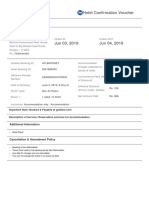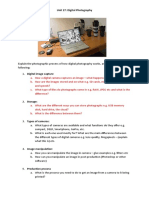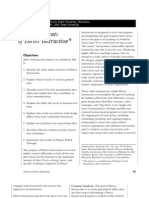Dual Coding Theory
Dual Coding Theory
Uploaded by
zep0Copyright:
Available Formats
Dual Coding Theory
Dual Coding Theory
Uploaded by
zep0Copyright
Available Formats
Share this document
Did you find this document useful?
Is this content inappropriate?
Copyright:
Available Formats
Dual Coding Theory
Dual Coding Theory
Uploaded by
zep0Copyright:
Available Formats
Dual-coding theory - Wikipedia, the free encyclopedia
http://en.wikipedia.org/wiki/Dual-coding_theory
Dual-coding theory
From Wikipedia, the free encyclopedia
Dual-coding theory, a theory of cognition, was hypothesized by Allan Paivio of the University of Western Ontario in 1971. Paivio used the idea that the formation of mental images aids in learning when developing this theory (Reed, 2010). According to Paivio, there are two ways a person could expand on learned material: verbal associations and visual imagery. Dual-coding theory postulates that both visual and verbal information is used to represent information (Sternberg, 2003). Visual and verbal information are processed differently and along distinct channels in the human mind, creating separate representations for information processed in each channel. The mental codes corresponding these representations are used to organize incoming information that can be acted upon, stored, and retrieved for subsequent use. Both visual and verbal codes can be used when recalling information (Sternberg, 2003). For example, say a person has stored the stimulus concept, dog as both the word 'dog' and as the image of a dog. When asked to recall the stimulus, the person can retrieve either the word or the image individually or both, simultaneously. If the word is recalled, the image of the dog is not lost and can still be retrieved at a later point in time. The ability to code a stimulus two different ways increases the chance of remembering that item compared to if the stimulus was only coded one way. There are limitations to the dual-coding theory. Dual-coding theory does not take into account the possibility of cognition being mediated by something other than words and images. Not enough research has been done to determine if words and images are the only way we remember items, and the theory would not hold true if another form of codes were discovered (Pylyshyn, 1973). Another limitation of the dual-coding theory is that it is only valid in for tests on which people are asked to focus on identifying how concepts are related (Reed, 2010). If associations between a word and an image cannot be formed, it is much harder to remember and recall the word at a later point in time. While this limits the effectiveness of the dual-coding theory, it is still valid over a wide range of circumstances and can be used to improve memory (Reed, 2010).
Contents
1 Types of Codes 2 Support for this theory 2.1 Psychology Support 2.2 Cognitive Neuroscience Support 3 Alternative Theory 4 For further reading 5 References 6 External links
Types of Codes
Analogue codes are used to mentally represent images. Analogue codes retain the main perceptual features of whatever is being represented, so the images we form in our minds are highly similar to the physical stimuli. They are a near-exact representation of the physical stimuli we observe in our environment, such as trees and rivers (Sternberg, 2003). Symbolic codes are used to for mental representations of words. They represent something conceptually, and
1 of 4
19/08/2013 09:57
Dual-coding theory - Wikipedia, the free encyclopedia
http://en.wikipedia.org/wiki/Dual-coding_theory
sometimes, arbitrarily, as opposed to perceptually. Similar to the way a watch may represent information in the form of numbers to display the time, symbolic codes represent information in our mind in the form of arbitrary symbols, like words and combinations of words, to represent several ideas. Each symbol (x, y, 1, 2, etc.) can arbitrarily represent something other than itself. For instance, the letter x is often used to represent more than just the concept of an x, the 24th letter of the alphabet. It can be used to represent a variable x in mathematics, or a multiplication symbol in an equation. Concepts like multiplication can be represented symbolically by an "x" because we arbitrarily assign it a deeper concept. Only when we use it to represent this deeper concept does the letter "x" carry this type of meaning.
Support for this theory
Psychology Support
Many researchers today have agreed that only words and images are used in mental representation (Pylyshyn, 1973). Supporting evidence shows that memory for some verbal information is enhanced if a relevant visual is also presented or if the learner can imagine a visual image to go with the verbal information. Likewise, visual information can often be enhanced when paired with relevant verbal information, whether real-world or imagined (Anderson & Bower, 1973). This theory has been applied to the use of multimedia presentations. Because multimedia presentations require both spatial and verbal working memory, individuals dually code information presented and are more likely to recall the information when tested at a later date (Brunye, Taylor, & Rapp, 2008). Paivio found that participants when shown a rapid sequence of pictures as well as a rapid sequence of words and later asked to recall the words and pictures, in any order, were better at recalling images. Participants, however, more readily recalled the sequential order of the words, rather than the sequence of pictures. These results supported Paivio's hypothesis that verbal information is processed differently than visual information and that verbal information was superior to visual information when sequential order was also required for the memory task (Paivio, 1969). Lee Brooks conducted an experiment that provided additional support for two systems for memory. He had participants perform either a visual task, where they had to view a picture and answer questions about the picture, or a verbal task, where they listened to a sentence and were then asked to answer questions pertaining to the sentence. To respond to the questions, participants were asked to either respond verbally, visually, or manually. Through this experiment, Brooks found that interference occurred when a visual perception was mixed with manipulation of the visual task, and verbal responses interfere with a task involving a verbal statement to be manually manipulated. This supported the idea of two codes used to mentally represent information (Sternberg 2003). Working memory as proposed by Alan Baddeley includes a two-part processing system with a visuospatial sketchpad and a phonological loop which essentially maps to Paivios theory. Dual-coding theories complement a dual-route theory of reading. When people read written information, dual-route theory contends that the readers access orthographic and phonological information to recognize words in the writing. Paivios work has implications for literacy, visual mnemonics, idea generation, HPT, human factors, interface design, as well as the development of educational materials among others. It also has implications for, and counterparts in, cognitive sciences and computational cognitive modeling (in the form of dual process cognitive models and so on; e.g., Anderson, 2005; Just et al., 2004, Sun, 2002). It also has had implications for cognitive robotics.
2 of 4
19/08/2013 09:57
Dual-coding theory - Wikipedia, the free encyclopedia
http://en.wikipedia.org/wiki/Dual-coding_theory
Cognitive Neuroscience Support
Two different methods have been used to identify the regions involved in visual perception and visual imagery. Cerebral blood flow allows researchers to identify the amount of blood and oxygen travelling to a specific part of the brain, with an increase in blood flow providing a measure of brain activity. An event related potential can be used to show the amount of electrical brain activity that is occurring due to a particular stimulus. Researchers have used both methods to determine which areas of the brain are active with different stimuli, and results have supported the dual-coding theory. Other research has been done with positron emission tomography (PET) scans and functional magnetic resonance imaging (fMRI) to show that participants had improved memory for spoken words and sentences when paired with an image, imagined or real, and showed increased brain activation to process abstract words not easily paired with an image.
Alternative Theory
Dual-coding theory is not accepted by everyone. John Anderson and Gordon Bower proposed an alternative method - the propositional theory - of how knowledge is mentally represented. The propositional theory claims that mental representations are stored as propositions rather than as images. Here, proposition is defined as the meaning that underlies the relationship between concepts (Sternberg, 2003). This theory states that images occur as a result of other cognitive processes because knowledge is not represented in the form of images, words, or symbols. The common coding theory has also been proposed as an alternative to dual coding theory. The common coding theory looks at how things we see and hear are connected to our motor actions. It claims that there is a common code that is shared between perceiving something and the respective motor action.
For further reading
Multimedia Learning
References
Anderson, J. R. (2005). Cognitive Psychology and its implications. New York: Worth Publishers. Anderson, J. R. & Bower, G. H. (1973). Human associative memory. Washington, DC: Winston. Baddeley, A. D. (1986). Working memory. Oxford: Oxford University Press. Brunye, T. T., Taylor, H. A., & Rapp, D. N. (2008). Repetition and dual coding in procedural multimedia presentations. Applied Cognitive Psychology, 22, 877-895. Denis, M. and Mellet, E. (2002). Neural bases of image and language interactions. International Journal of Psychology, 37 (4), 204-208. Just, M. et al. (2004). Imagery in sentence comprehension: an fMRI study. NeuroImage 21, 112-124. Mayer, R. E. & Moreno, R. (2003). Nine ways to reduce cognitive load in multimedia learning. Educational Psychologist, 38(1), 43-52. Moreno, R., & Mayer, R. E. (2000). A coherence effect in multimedia learning: the case for minimizing irrelevant sounds in the design of multimedia instructional messages. Journal of Educational Psychology, 92, 117-125. Paivio, A (1969). Mental Imagery in associative learning and memory. Psychological Review, 76(3), 241-263. Paivio, A (1971). Imagery and verbal processes. New York: Holt, Rinehart, and Winston.
3 of 4
19/08/2013 09:57
Dual-coding theory - Wikipedia, the free encyclopedia
http://en.wikipedia.org/wiki/Dual-coding_theory
Paivio, A (1986). Mental representations: a dual coding approach. Oxford. England: Oxford University Press. Sternberg, Robert J. (2006). Cognitive psychology fourth edition. Thomson Wadsworth. pp. 23436. ISBN 0-534-51421-9. Pylyshyn, Z. W. (1973). What the mind's eye tells the mind's brain: A critique of mental imagery. Psychological Bulletin, 80, 1-24. Reed, S. K. (2010). Cognition: Theories and application (8th ed.). Belmont, CA: Wadsworth Cengage Learning. Sternberg, R. J. (2003). Cognitive theory (3rd ed.). Belmont, CA: Thomson Wadsworth. Sun, R. (2002). Duality of the Mind. Mahwah, NJ: Lawrence Erlbaum Associates. Thomas, N. J.T., "Mental imagery", The Stanford Encyclopedia of Philosophy (Winter 2011 Edition), Edward N Zalta (ed.).
External links
Multiple Code Theory (http://www.thereferentialprocess.org/theory/multiple-code-theory) Retrieved from "http://en.wikipedia.org/w/index.php?title=Dual-coding_theory&oldid=561218644" Categories: Cognitive science Educational psychology Linguistics This page was last modified on 23 June 2013 at 15:29. Text is available under the Creative Commons Attribution-ShareAlike License; additional terms may apply. By using this site, you agree to the Terms of Use and Privacy Policy. Wikipedia is a registered trademark of the Wikimedia Foundation, Inc., a non-profit organization.
4 of 4
19/08/2013 09:57
You might also like
- Goibibo Hotel BillDocument4 pagesGoibibo Hotel BillBanani Das33% (3)
- Telling Stories With Data With Applications in R 9781032134772 9781032133430 9781003229407 2022058452 2022058453 - CompressDocument623 pagesTelling Stories With Data With Applications in R 9781032134772 9781032133430 9781003229407 2022058452 2022058453 - CompressEdu cruz sauñeNo ratings yet
- CTE 7040 - Jessica Pudlio Cultural Lesson PlanDocument3 pagesCTE 7040 - Jessica Pudlio Cultural Lesson PlanJessica PulidoNo ratings yet
- As 1860.2-2006 Particleboard Flooring InstallationDocument7 pagesAs 1860.2-2006 Particleboard Flooring InstallationSAI Global - APAC0% (1)
- Unit 27 Photography ResearchDocument8 pagesUnit 27 Photography Researchapi-530043460100% (1)
- Preparing A SyllabusDocument7 pagesPreparing A SyllabusMr DamphaNo ratings yet
- Make Your Own Project-Based Lesson PlanDocument14 pagesMake Your Own Project-Based Lesson PlanSamael MorningstarNo ratings yet
- Tpack Lesson PlanDocument5 pagesTpack Lesson Planapi-350281802No ratings yet
- Colonialism and Neocolonialism by Jean Paul Sartre PDFDocument2 pagesColonialism and Neocolonialism by Jean Paul Sartre PDFKatrina0% (1)
- ETEC 512 - Learning Scenario AnalysisDocument8 pagesETEC 512 - Learning Scenario AnalysisKylie NeiserNo ratings yet
- Telangana State Board of Intermediate Education: Hyderabad: Online Memorandum of MarksDocument1 pageTelangana State Board of Intermediate Education: Hyderabad: Online Memorandum of MarksSaikishore Naidu100% (2)
- Principles of Information Security 4th Edition Whitman Test BankDocument5 pagesPrinciples of Information Security 4th Edition Whitman Test Bankxasuhymu100% (3)
- KENWOOD 60cm Dishwasher - Silver KDW60S16 ManualDocument36 pagesKENWOOD 60cm Dishwasher - Silver KDW60S16 ManualJuan Antonio Palacios ClavijoNo ratings yet
- Descriptive ResearchDocument3 pagesDescriptive ResearchBullish GuyNo ratings yet
- The Relational Basis of EmpowermentDocument43 pagesThe Relational Basis of EmpowermentThe Centre for Welfare Reform100% (1)
- Engaging Children in Stem Education Early Natural StartDocument5 pagesEngaging Children in Stem Education Early Natural Startapi-378350740No ratings yet
- Parachute FullmoduleDocument56 pagesParachute Fullmoduleapi-396577001No ratings yet
- Tpack Template Creating Lesson Plan 1Document3 pagesTpack Template Creating Lesson Plan 1api-366475403No ratings yet
- Academic Interventions Module PDFDocument34 pagesAcademic Interventions Module PDFJaneNo ratings yet
- Gamification and Game-Based LearningDocument17 pagesGamification and Game-Based LearningHammad AliNo ratings yet
- Running Head: ETEC 500 FINAL ASSIGNMENT 1Document19 pagesRunning Head: ETEC 500 FINAL ASSIGNMENT 1adsmauricioNo ratings yet
- Universal Design For Learning As A Theory of Inclusive Practice For Use by Educational PsychologistsDocument16 pagesUniversal Design For Learning As A Theory of Inclusive Practice For Use by Educational PsychologistsdiniNo ratings yet
- Anchor ActivitiesDocument16 pagesAnchor ActivitiesFlorencia Soledad RoveranoNo ratings yet
- Research Proposal Assignment 08Document3 pagesResearch Proposal Assignment 08sahhhhhhhNo ratings yet
- I Like Me UdlDocument7 pagesI Like Me Udlapi-227929120No ratings yet
- ComparisonDocument23 pagesComparisonHanny HusrunNo ratings yet
- Module 1Document11 pagesModule 1Bon Eliaj BacalNo ratings yet
- Gestalt and Schema TheoriesDocument14 pagesGestalt and Schema TheoriesJhonabieNo ratings yet
- Using Behavioral Skills Training To Teach Behavioral Interventions and Milieu Teaching: A Systematic Review of The Literature and Empirical InvestigationDocument165 pagesUsing Behavioral Skills Training To Teach Behavioral Interventions and Milieu Teaching: A Systematic Review of The Literature and Empirical InvestigationBruno KudekenNo ratings yet
- 0002762tmp-O0-Ict in The Early Years Foundation StageDocument12 pages0002762tmp-O0-Ict in The Early Years Foundation StageNanaAduNanaNo ratings yet
- Language, Consciousness and The Bicameral Mind: Andreas@unstable - NLDocument4 pagesLanguage, Consciousness and The Bicameral Mind: Andreas@unstable - NLAnonymous kbmKQLe0JNo ratings yet
- Behaviourism Presentation NEWDocument61 pagesBehaviourism Presentation NEWasmi94100% (1)
- Dinosaur Choice BoardDocument9 pagesDinosaur Choice Boardapi-417558685No ratings yet
- Educ 580 Multimedia Project - Romeo and JulietDocument28 pagesEduc 580 Multimedia Project - Romeo and Julietapi-299317202No ratings yet
- Understanding Reality in A Bigger PictureDocument44 pagesUnderstanding Reality in A Bigger PictureReynerNo ratings yet
- Flight From ConversationDocument3 pagesFlight From ConversationNikola TeslaNo ratings yet
- Experimental Psychology (McGuigan, 1996) Chapter 12-14Document7 pagesExperimental Psychology (McGuigan, 1996) Chapter 12-14Anele BellaNo ratings yet
- Research Paradigms Full ArticleDocument14 pagesResearch Paradigms Full Articleparwinder1989100% (1)
- Effective Pedagogies For Online Teaching and Learning (Ruarte, 2019)Document7 pagesEffective Pedagogies For Online Teaching and Learning (Ruarte, 2019)Irbaz KhanNo ratings yet
- ETEC 512 Thought Paper 3 Prior KnowledgeDocument3 pagesETEC 512 Thought Paper 3 Prior KnowledgeSusan BeeleyNo ratings yet
- Assessment ProtocolDocument19 pagesAssessment Protocolapi-437360672No ratings yet
- Direct InstructionDocument36 pagesDirect InstructionRon Knorr. PhDNo ratings yet
- Digital Publishing RubricDocument3 pagesDigital Publishing Rubricapi-263007062No ratings yet
- Alexandra Penn's ApplicationDocument19 pagesAlexandra Penn's ApplicationThe Florida Times-UnionNo ratings yet
- Presented By: Deb NortonDocument21 pagesPresented By: Deb NortonDeb Norton100% (1)
- Learning To Learn - Metacognition: Cambridge School Conference Hong Kong 2017Document45 pagesLearning To Learn - Metacognition: Cambridge School Conference Hong Kong 2017Angelita Dela cruzNo ratings yet
- OREO Online LearningDocument1 pageOREO Online LearningGloriaNo ratings yet
- Thought Paper 2Document4 pagesThought Paper 2api-236492991No ratings yet
- Body Image Lesson Plan CSHDocument5 pagesBody Image Lesson Plan CSHapi-279500653No ratings yet
- Experiential LearningDocument5 pagesExperiential Learningmg9362No ratings yet
- Adult Education and The Social Media RevolutionDocument9 pagesAdult Education and The Social Media RevolutionLaura CNo ratings yet
- Assessment Packet Faml 360Document29 pagesAssessment Packet Faml 360api-291366747No ratings yet
- Feedback Quotes: Hattie & Timperley (2007)Document2 pagesFeedback Quotes: Hattie & Timperley (2007)GouravNo ratings yet
- Science Fair StudenthandbookDocument16 pagesScience Fair Studenthandbookapi-269924817No ratings yet
- Perceptions of Gender in Early YearsDocument21 pagesPerceptions of Gender in Early YearsJ WestNo ratings yet
- Critique of ConnectivismDocument2 pagesCritique of Connectivismapi-365047139No ratings yet
- Chapter 1 of Abnormal PsychologyDocument27 pagesChapter 1 of Abnormal PsychologyFaye Dorothy Hannah LimNo ratings yet
- Final Lesson PlanDocument11 pagesFinal Lesson Planapi-300064060No ratings yet
- VirtualRealityinEducationChrisChristou PDFDocument19 pagesVirtualRealityinEducationChrisChristou PDFRosyanto100% (1)
- The Philosophy of Teaching The Teacher, The Pupil, The SchoolFrom EverandThe Philosophy of Teaching The Teacher, The Pupil, The SchoolNo ratings yet
- Expanding Our PhilosophYDocument58 pagesExpanding Our PhilosophYBhea Marie SongcuyaNo ratings yet
- Harvard SEAS, Newsletter, Fall 2005Document20 pagesHarvard SEAS, Newsletter, Fall 2005Harvard School of Enginering and ANo ratings yet
- My Learning ManifestoDocument5 pagesMy Learning Manifestoapi-535075703No ratings yet
- Fvlma Ecc Assessment PDFDocument14 pagesFvlma Ecc Assessment PDFapi-264880707No ratings yet
- Final EssayDocument6 pagesFinal Essayapi-311773794No ratings yet
- Activating Students' Ideas: Linking Formative Assessment Probes to Instructional SequenceFrom EverandActivating Students' Ideas: Linking Formative Assessment Probes to Instructional SequenceNo ratings yet
- Glengarry Glen Ross, BlakeDocument5 pagesGlengarry Glen Ross, Blakezep0No ratings yet
- Vocabulary: Health and Medicine: Across DownDocument1 pageVocabulary: Health and Medicine: Across Downzep0No ratings yet
- Hyenas Have A Bad Rap-But They're Africa's Most Successful PredatorDocument9 pagesHyenas Have A Bad Rap-But They're Africa's Most Successful Predatorzep0No ratings yet
- Toothbruch CrisisDocument10 pagesToothbruch Crisiszep0No ratings yet
- Unmarked Modality PDFDocument1 pageUnmarked Modality PDFzep0No ratings yet
- How Do Scientists Date FossilsDocument6 pagesHow Do Scientists Date Fossilszep0No ratings yet
- Meet The Money Behind The Climate Denial Movement - Smart News - SmithsonianDocument3 pagesMeet The Money Behind The Climate Denial Movement - Smart News - Smithsonianzep0No ratings yet
- How Climate Cannge FueledDocument7 pagesHow Climate Cannge Fueledzep0No ratings yet
- Transitivity AnalysisDocument9 pagesTransitivity Analysiszep0No ratings yet
- How The Gut Microbiome Could Provide A New Tool To Treat AutismDocument7 pagesHow The Gut Microbiome Could Provide A New Tool To Treat Autismzep0No ratings yet
- A Whale Is Pining For The Fjords, and Norwegians Are Worried - ReutersDocument8 pagesA Whale Is Pining For The Fjords, and Norwegians Are Worried - Reuterszep0No ratings yet
- Rock Art and Footprints Reveal How Ancient Humans Responded To Volcanic Eruption - Smart News - SmithsonianDocument3 pagesRock Art and Footprints Reveal How Ancient Humans Responded To Volcanic Eruption - Smart News - Smithsonianzep0No ratings yet
- Neanderthals What We KnowDocument26 pagesNeanderthals What We Knowzep0100% (1)
- Meet The Dinos of Deep Time' - at The Smithsonian - SmithsonianDocument14 pagesMeet The Dinos of Deep Time' - at The Smithsonian - Smithsonianzep0No ratings yet
- What Exactly Is Duck Sauce? - Arts & Culture: FEBRUARY 5, 2015Document5 pagesWhat Exactly Is Duck Sauce? - Arts & Culture: FEBRUARY 5, 2015zep0No ratings yet
- Are You Optimistic About The Earth's Future - Climate Change - Smithsonian Second OpinionDocument75 pagesAre You Optimistic About The Earth's Future - Climate Change - Smithsonian Second Opinionzep0No ratings yet
- A Smithsonian Curator Reflects On Apollo 10, The Mission That Made Landing On The Moon Possible - Science - SmithsonianDocument9 pagesA Smithsonian Curator Reflects On Apollo 10, The Mission That Made Landing On The Moon Possible - Science - Smithsonianzep0No ratings yet
- Dinosaur BonesDocument8 pagesDinosaur Boneszep0No ratings yet
- British To Quit Iraq in A Year': M S S BDocument2 pagesBritish To Quit Iraq in A Year': M S S Bzep0No ratings yet
- Compass of LifeDocument3 pagesCompass of LifeJimson SantiagoNo ratings yet
- NURS 215 - Spring 2023Document8 pagesNURS 215 - Spring 2023Nhi DaoNo ratings yet
- 2012 Factory and Suppliers GuideDocument1 page2012 Factory and Suppliers GuideMatthew HinesNo ratings yet
- CHE 105 Fall 2019 Exam 1: Your Name: Your IDDocument22 pagesCHE 105 Fall 2019 Exam 1: Your Name: Your IDRamenKing12No ratings yet
- The Ultimate Tofu Recipe Book Just So Many Tasty Ways To Enjoy TofuDocument45 pagesThe Ultimate Tofu Recipe Book Just So Many Tasty Ways To Enjoy TofuEmerbelle Cheng100% (1)
- Acomplishment Report For One Week Health ActivitiesDocument8 pagesAcomplishment Report For One Week Health ActivitiesEi Leen100% (1)
- AMEM Cruise Ships On OrderDocument10 pagesAMEM Cruise Ships On OrderDudu LauraNo ratings yet
- Nursing Care Plan: Davao Doctors College Nursing ProgramDocument1 pageNursing Care Plan: Davao Doctors College Nursing ProgramCrissa KayeNo ratings yet
- The Life and Works of RizalDocument31 pagesThe Life and Works of RizalAlvin Magallen Rebusa100% (1)
- Class_8_Industries_NotesDocument3 pagesClass_8_Industries_Notessenitasimon8No ratings yet
- Info Pract Xi QP Hy 2024 25Document4 pagesInfo Pract Xi QP Hy 2024 25rajesh.mountabuNo ratings yet
- Week7 Equity MKT 1: You Have CompletedDocument5 pagesWeek7 Equity MKT 1: You Have CompletedDerek LowNo ratings yet
- Drug ExpiryDocument3 pagesDrug Expiryhap hazardNo ratings yet
- Statement of The PetitionerDocument2 pagesStatement of The PetitionerMinnie AgdeppaNo ratings yet
- Grameen PhoneDocument44 pagesGrameen PhoneDipock Mondal100% (1)
- Pertemuan 7 Fungsi ProduksiDocument19 pagesPertemuan 7 Fungsi ProduksiCanderaNo ratings yet
- ApproachingPBLPracticallySept 08 PDFDocument28 pagesApproachingPBLPracticallySept 08 PDFthNo ratings yet
- DC16 Ch11Document65 pagesDC16 Ch11Pete JoempraditwongNo ratings yet
- PDF Cult of Umiera V1Document29 pagesPDF Cult of Umiera V1M. P. T.No ratings yet
- A319 320 Fault Verification GuideDocument62 pagesA319 320 Fault Verification GuideAnonymous afPplXbcNo ratings yet
- Beef Served To Animals of DR. Shyamaprasad Mukerjee Zoological Garden, Municipal Corporation, Surat, GujaratDocument31 pagesBeef Served To Animals of DR. Shyamaprasad Mukerjee Zoological Garden, Municipal Corporation, Surat, GujaratNaresh KadyanNo ratings yet
- Arthur M Young Astrology As CosmologyDocument8 pagesArthur M Young Astrology As CosmologyIván FélixNo ratings yet
- Complicity in CrimesDocument42 pagesComplicity in Crimesbharat bhat100% (1)
- Division Memo For The Orientation of Test Constructors 2021Document9 pagesDivision Memo For The Orientation of Test Constructors 2021maynard baluyutNo ratings yet












































































































